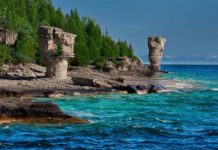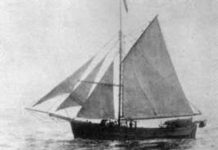The Alaskan-Yukon boundaries were respected until the Klondike Gold Rush began. Arguments and tribunals ensued, the British sided with US and Canada lost.
The shores of the Alaska Panhandle form a ragged line with mountains, inlets, points and channels forming the coastline. Purchasing Alaska from the Russians in 1867, the United States of America used the 1825 Anglo-Russian Treaty as the official Alaskan map; the agreement “established an ambiguous boundary line north of latitude 54 degrees 40 feet,” said Paul Barsauskas in “The Alaska Boundary Dispute: Anglo-Canadian Imperialism and the American Influence, 1898-1903,” History of Canada Online. The boundary line was “’to follow the summit of the mountains situated parallel to the coast between British and Russian territories… in many of these regions, however, no such mountains existed.”
Canada Claimed Panhandle Fiords
After British Columbia joined Confederation in 1871, Canada attempted to lay claim to fiords in the Alaskan panhandle that permitted access to the Yukon. The US denied the claims. Canada pressed for the claims again in 1898 after the Klondike fields of glittering gold nuggets were discovered in the Yukon the year before. Access to ports would be essential for the Yukon prospectors, with Juneau, Skagway and Dyea in handy reach. A joint commission of the two countries was initiated.
Gold Obsession a Motive
It seemed a settlement was in reach. Retaining sovereign control over Canada, the British government installed one British member on the commission plus five Canadians, the Americans composed the opposition. Negotiations failed when neither side would compromise. Discussions ended in February 1899 and Canadians “released latent feelings of anti-Americanism which were expressed in publicly aggressive terms,” said Barsauskas. “The obsession for gold showed that economic motives were primarily behind the dispute.”
Alaska Boundary Dispute a Challenge to US Strength
A second attempt was made to settle the Alaska Boundary Dispute in 1902. A tribunal was set up with three Americans, two Canadian lawyers – Sir Louis Jette and Allen B. Aylesworth – and one British representative – Chief Justice Lord Richard E.W. Alvarstone. Meeting in London, the Americans Elihu Root (Secretary of War) and Senators Henry Cabot Lodge and George Turner were determined to maintain the United States’ grasp on the coastal boundary. The Americans considered the clash as a serious challenge of their political strength, so seriously that President Theodore Roosevelt threatened war on Canada and Britain, should Canada win.
Canadians Lost Dispute
Ending on October 20, 1903 in Washington, D.C., the Canadians departed upset and short-changed. British tribunal member Lord Alvarstone voted with the Americans, keeping the three ports requested by Canada in Alaskan hands by drawing the boundary line around them. Two of four islands at the mouth of the Portland Canal were allotted to Canada. Fearful of the threatened attack, Lord Alvarstone was also concerned with remaining military and political allies with the United States. Infuriated at the British pronouncement to ignore a member of its colonial empire, the two Canadians refused to sign the judgment.
The Alaska Boundary Dispute decision ignited patriotic passion for Canada and anti-British feelings. Prime Minister Wilfred Laurier “asserted that Canada’s lack of treaty-making power made it difficult to maintain its rights internationally,” said D.M.L. Farr in “Alaska Boundary Dispute” in the Canadian Encyclopedia. Gradually, Canada moved toward independence while remaining in the Commonwealth, with the repatriation of the 1867 British-North America Act in 1982. The Constitution Act was enacted by Prime Minister Pierre Elliot Trudeau, giving Canada control over its own decisions and no longer requiring British approval. The Canadian Charter of Rights and Freedoms was added at the same time.
Sources:
- Barsauskas, Paul, “The Alaska Boundary Dispute: Anglo-Canadian Imperialism and the American Influence, 1898-1903,” Canada Channel.
- Farr, D.M.L., “Alaska Boundary Dispute,” The Canadian Encyclopedia
- Ricketts, Bruce, “The BC – Alaska Boundary Dispute,” Mysteries of Canada







